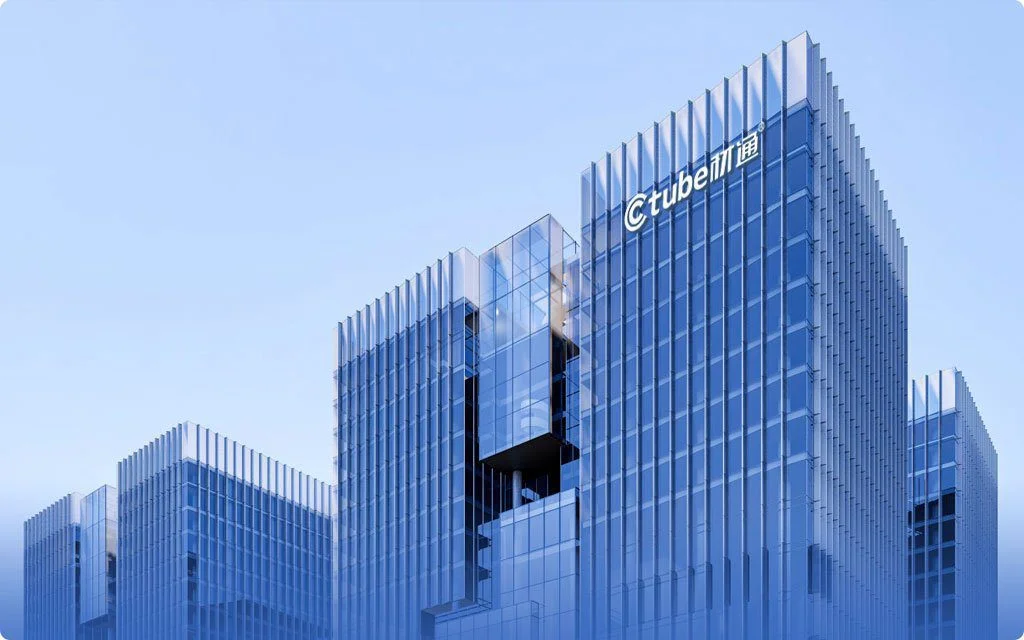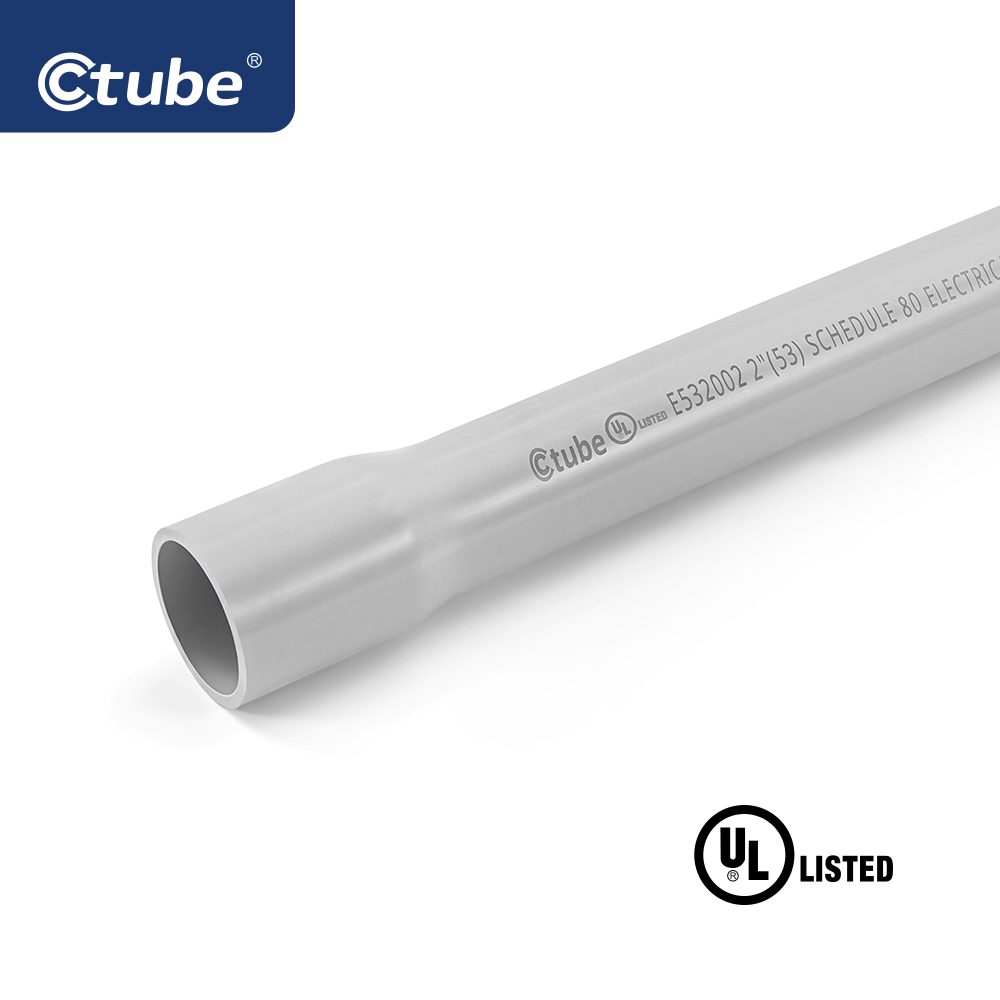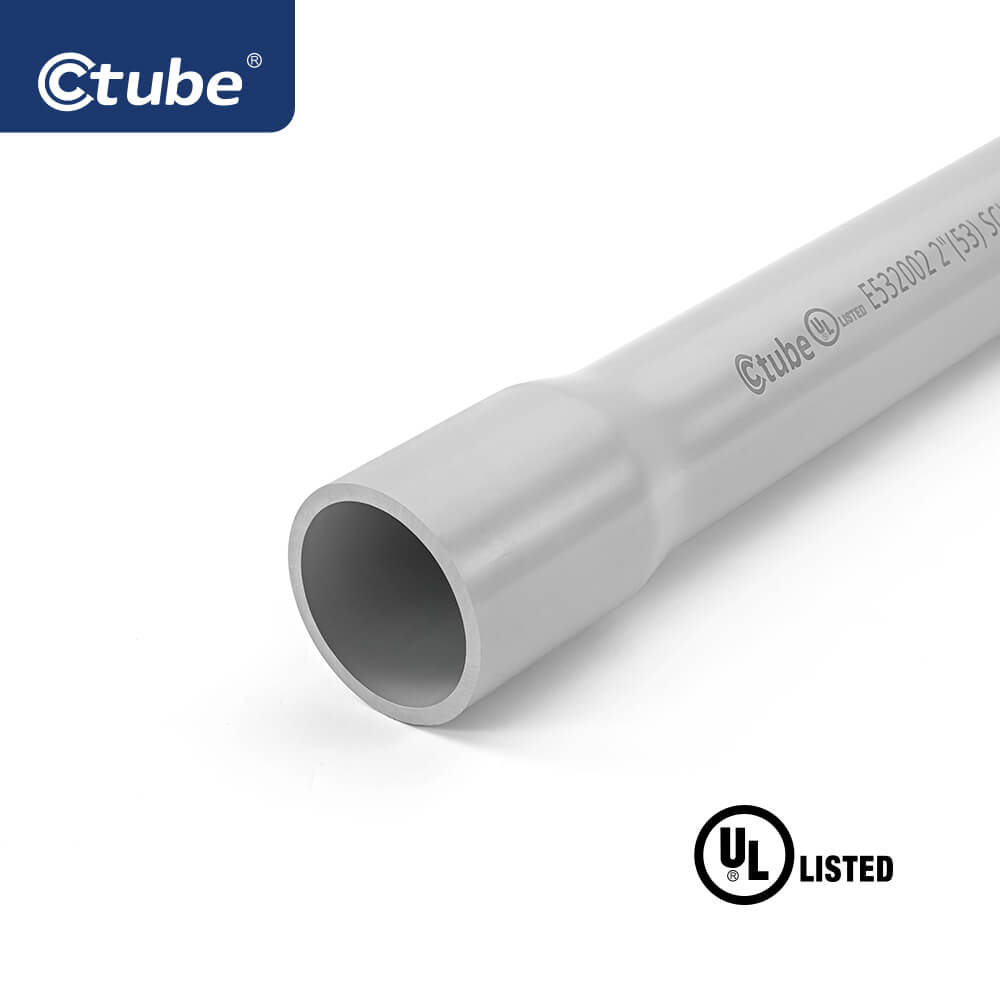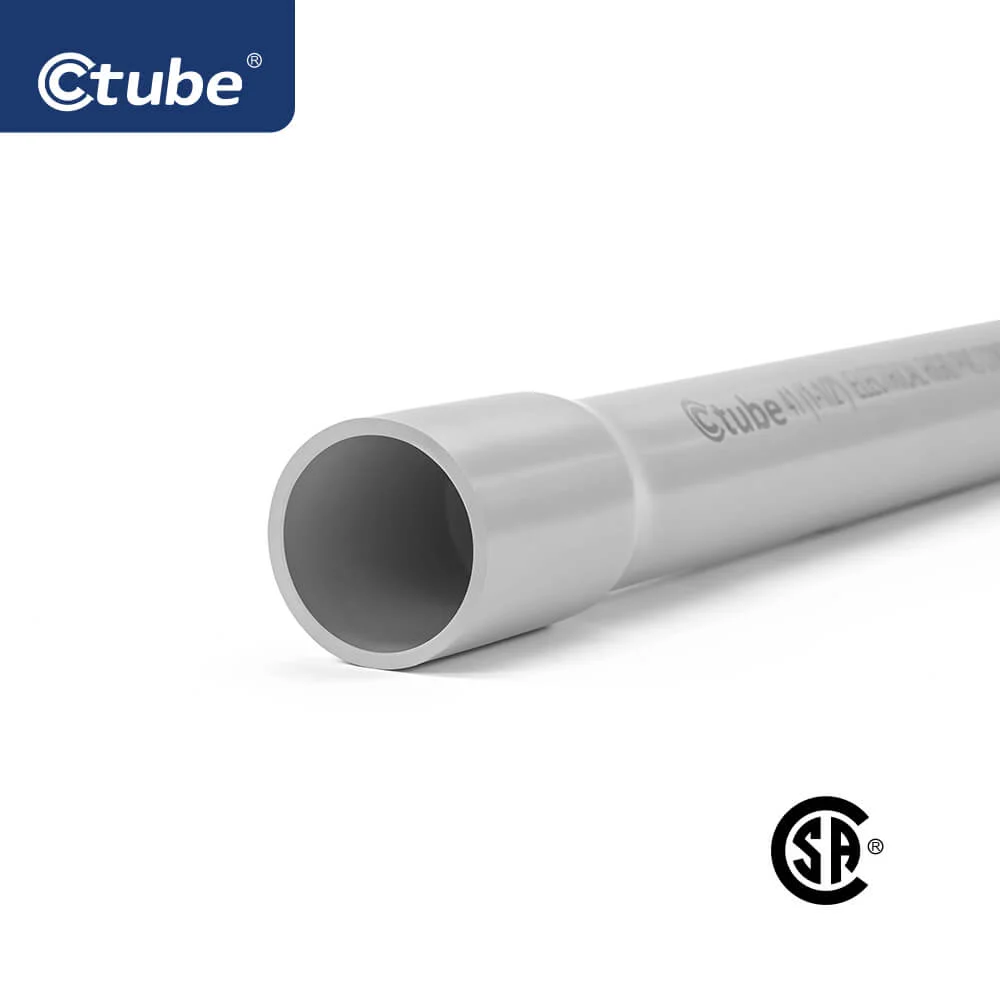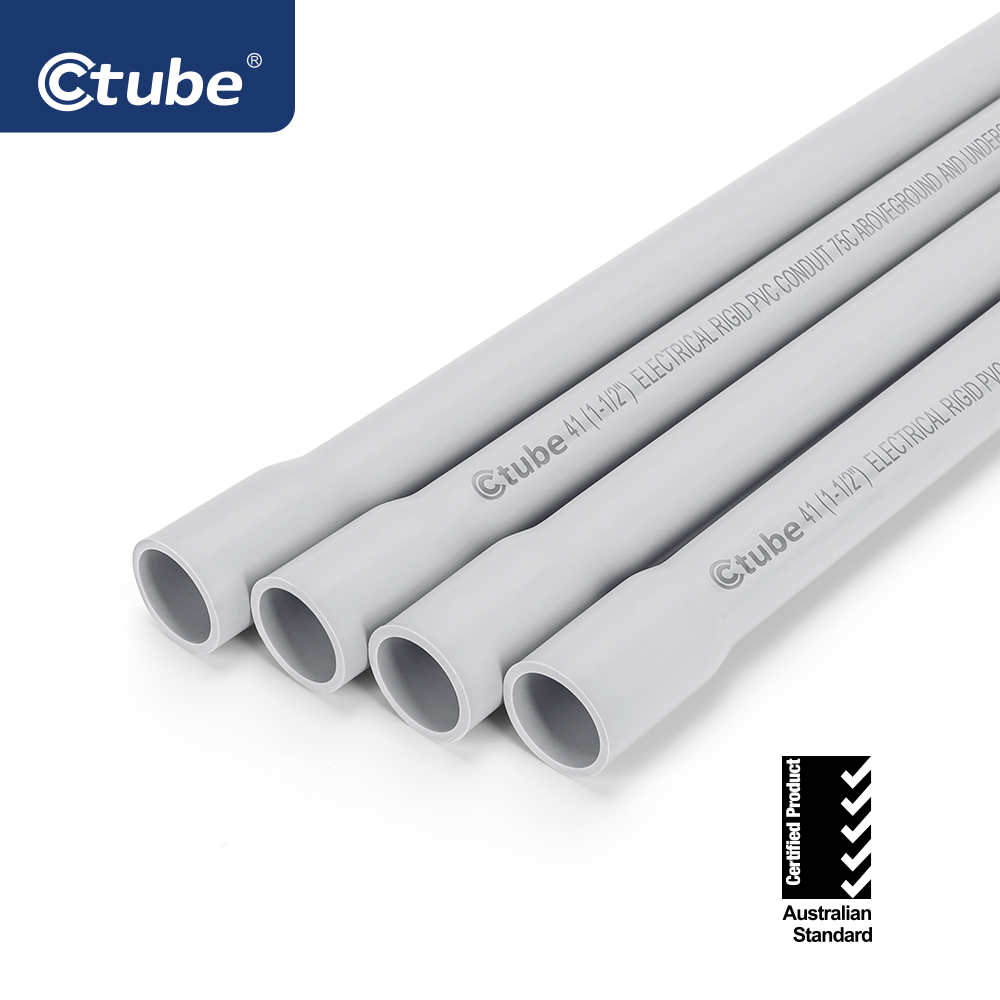Table of Contents
Toggle1. Introduction
If you’ve ever worked on a construction site or looked inside a building’s wiring system, chances are you’ve come across PVC conduit. It’s one of the most common materials used to protect electrical cables—especially in residential, commercial, and even industrial projects.
But have you ever stopped to ask: what exactly is PVC? What does the name stand for? Why is it used so widely in conduit systems? And how does it compare with other materials like metal or HDPE?
In this post, we’ll answer the question above in detail. Whether you’re an electrical engineer, a contractor, or someone sourcing materials for a project, this guide will give you a clear understanding of PVC and PVC conduit.
Let’s start with the basics.
2. What Does PVC Stand For?
PVC stands for Polyvinyl Chloride—a name that sounds complex but breaks down easily when you look at its parts:
“Poly” means “many”, “Vinyl” refers to the vinyl group (–CH=CH2), a key chemical structure, “Chloride” comes from chlorine, one of the two raw materials used to make it.
Put it all together, and Polyvinyl Chloride simply means “many vinyl chloride molecules joined together.” This structure gives PVC its strength and durability.
Polyvinyl chloride is one of the most widely used thermoplastic polymers in the world. It can be softened and reshaped when heated—then hardened again when cooled. That makes it perfect for manufacturing pipes, conduits, and fittings of all sizes and shapes.
📘 PVC was first discovered in the 19th century, but it wasn’t until the 1920s–30s that it became commercially viable. Over the decades, engineers and chemists have improved its performance with additives—making today’s PVC products stronger, safer, and more versatile than ever.
3. How PVC Is Made: From Raw Materials to Rigid Conduit
PVC isn’t just scooped out of a barrel or melted down like metal—it’s a product of chemistry, carefully manufactured to meet exact performance standards.
🧪 Raw Materials: Salt + Oil = PVC
It might surprise you, but one of the main ingredients in PVC is common salt (yes, the same sodium chloride used in cooking).
PVC is made from two key raw materials: Chlorine, which comes from salt (NaCl) through electrolysis.
Ethylene, which is derived from crude oil or natural gas
These two ingredients are combined to create vinyl chloride monomer (VCM)—a gaseous compound that becomes the foundation of PVC resin.
🔄 Polymerization: Turning Gas into Solid
Once VCM is produced, it goes through a process called polymerization, where individual vinyl chloride molecules are chemically bonded to form long chains—this is what gives Poly-vinyl Chloride its name.
The result is a fine, white powder known as PVC resin.
But the resin alone isn’t strong or stable enough to be used in electrical conduit. It needs help—so let’s talk about additives.
🧩 Compounding: The Secret Behind Conduit Performance
To make the PVC suitable for conduit manufacturing, producers add a carefully designed blend of ingredients to the resin. This is called PVC compounding.
Common additives include:
| Additive Type | Purpose |
|---|---|
| Heat stabilizers | Prevent degradation during extrusion and use |
| Impact modifiers | Improve toughness and resistance to cracking |
| UV stabilizers | Protect against sunlight and weathering (especially for outdoor conduit) |
| Flame retardants | Enhance fire resistance |
| Lubricants | Aid in smooth extrusion and prevent surface defects |
| Color pigments | Allow color coding for different conduit applications (e.g., gray, black, orange) |
The final compound determines how the conduit will perform under stress, in sunlight, underground, or near heat sources.
Tip: Premium-grade conduit often uses lead-free, RoHS-compliant stabilizers and includes UV inhibitors—ideal for long-term outdoor applications like solar or rooftop installations.
🏭 Extrusion: Shaping the Conduit
Once the PVC compound is ready, it’s melted and pushed through an extruder—a machine that forms the conduit into its final shape, usually a round tube of a specific diameter and wall thickness (e.g., Schedule 40).
After shaping, the conduit is:
- Cooled using water or air
- Stamped with compliance markings (e.g., UL, CSA)
- Cut to length (usually 3m, 10ft, or 20ft)
- Tested for mechanical strength, flame resistance, etc.
From here, it’s ready to be packed, shipped, and installed on job sites around the world.
🏗️ Why the Manufacturing Process Matters
The formulation affects how well the conduit resists UV, impact, and chemicals.
The extrusion quality determines smoothness and dimensional accuracy.
The testing standards (UL651, CSA C22.2, IEC) ensure it meets safety codes.
PVC may start as salt and gas, but by the time it reaches your job site as rigid conduit, it’s a precisely engineered product designed to protect lives and systems.
In the next section, we’ll explore the different types of PVC used in conduit systems—and how to choose the right one for your application.
4. Types of PVC Used in Electrical Applications: uPVC vs PVC
When it comes to electrical installations, not all PVC is the same. The type of PVC you choose can directly affect the safety, durability, and compliance of your project—whether you’re wiring a home, powering a factory, or installing a solar energy system.
When it comes to PVC conduit, it’s easy to get confused by the terms “rigid” and “flexible.” These words usually describe the shape or mechanical form of the conduit.
However, in this section, we’re not just talking about shape—we’re talking about the material itself.
So while you might hear “rigid PVC” and assume it always means uPVC, or see “flexible conduit” and think it must be made from soft plastic, that’s not always the case.
The material used—whether unplasticized or plasticized—has a much greater impact on performance than just shape alone.
If you’re shopping for electrical conduit, you’ll most likely come across two terms: uPVC and PVC. While they might seem similar at first glance—they’re both made from polyvinyl chloride—their performance, physical characteristics, and applications are very different.
🧱 uPVC (Unplasticized PVC)
uPVC stands for unplasticized polyvinyl chloride. As the name suggests, it contains no plasticizers—chemicals that are usually added to soften plastic materials. Because of this, uPVC is rigid, durable, and strong.
🔍 Fun Fact: In some markets, rigid conduit is simply referred to as “uPVC pipe,” even though it may include additives for UV or flame resistance.
🧰 pPVC (Plasticized PVC)
Plasticized PVC—often called flexible PVC—is a modified version of standard PVC that includes plasticizers.
These are chemical additives (like phthalates or safer alternatives) that are added during production to increase flexibility, softness, and elasticity.
5. Material Properties That Make PVC Ideal for Electrical Conduits
Why do electrical professionals around the world choose PVC for conduit systems?
It’s not just about cost or ease of installation.
PVC has a unique combination of material properties that make it especially suitable for protecting electrical wiring in a wide range of environments—from dry indoor walls to buried underground systems and exposed rooftop solar setups.
Let’s break down the key reasons why PVC is such a reliable choice.
One of the most important jobs of a conduit is to prevent electrical current from escaping and protect people and property from shock.
PVC is a natural insulator—it doesn’t conduct electricity.
⚡ PVC conduit helps isolate and protect electrical circuits without needing extra insulation layers.
PVC conduit offers outstanding resistance to both chemical corrosion and moisture damage, making it a top choice for demanding environments.
Unlike metal conduits, it does not rust, oxidize, or degrade when exposed to water, salts, or chemicals.
💡 This resistance comes from the chemical stability of the PVC polymer itself, which remains unaffected by most acids, alkalis, and industrial compounds. That means there’s no need for painting, coating, or galvanizing—PVC holds up naturally.
💧 Even in direct burial applications, PVC conduit maintains its performance and shape over time—delivering durable protection in places where metal would fail.
🔥Safety is a top concern in any electrical installation, and flame retardancy is a key property that sets PVC conduit apart.
🧯Many high-quality PVC conduits are formulated with built-in flame-retardant additives that prevent the material from fueling a fire.
These conduits can meet stringent international standards, such as:
UL 94 V-0 or V-1, which rate how quickly a material stops burning after flame exposure
IEC 61386, which evaluates a conduit’s behavior under fire and heat conditions
What does this mean in real-world terms? If PVC conduit is exposed to open flame, it’s designed to self-extinguish—rather than continue burning and spreading fire through a building.
This is especially critical in residential, commercial, and public buildings, where electrical fires can have devastating consequences.
✅ Choosing flame-rated conduit adds an important layer of protection for people, property, and systems—especially when running wiring through ceilings, walls, or confined spaces.
☀️PVC conduit used outdoors is constantly exposed to sunlight. Without proper protection, ultraviolet (UV) rays can break down the material over time—causing it to fade, crack, or become brittle.
To prevent this, many conduit suppliers use UV stabilizers during manufacturing that help extend the lifespan and performance of the conduit in harsh outdoor environments.
Some even carefully select different UV additives based on conduit color and application.
✅ Carbon Black: Ideal for black PVC conduit, this additive absorbs and blocks UV radiation.
It’s one of the most effective ways to prevent sun damage, and can keep conduit strong and flexible for over years.
✅ Titanium Dioxide (TiO₂): Used in white or light-colored conduit, TiO₂ reflects UV rays and prevents surface chalking and color fading.
It also has high chemical stability and is widely recognized as safe and effective—even used in cosmetics and food packaging.
It is specifically referenced in the AS/NZS 2053 standard for improving outdoor durability of rigid PVC conduit.
💡In addition to its strong technical performance, PVC conduit offers significant practical advantages that make it a preferred choice across the electrical industry.
Lightweight Structure: PVC is much lighter than metal alternatives like steel or aluminum, making it easier to transport, handle, and install—especially in overhead or tight-space applications.
Simple Installation: PVC conduit can be cut quickly using basic hand tools, with no need for specialized equipment. It requires no threading, welding, or grounding, which simplifies on-site work and speeds up installation.
Labor and Transport Savings: The ease of handling and reduced installation time directly translate into lower labor costs. Its lightweight nature also reduces shipping and freight expenses, particularly on large projects.
These features make PVC conduit a cost-effective solution for a wide range of projects—from residential wiring to large-scale commercial or infrastructure installations.
It’s no surprise that electricians, contractors, and even DIY installers consistently choose PVC for its reliability and ease of use.
6. Real-World Applications of PVC Conduit
After introducing some benefits of PVC and PVC conduit, let’s explore some common real-world scenarios where PVC conduit is the ideal choice.
Residential Wiring: PVC conduit protects home electrical wiring in walls, basements, kitchens, and bathrooms. Its insulation and moisture resistance make it safe and easy to install.
Commercial and Office Buildings: Used for routing power and data cables, PVC conduit meets fire safety standards and adapts well to bends with flexible options.
Industrial Environments: Resistant to chemicals, moisture, and impact, PVC conduit is ideal for factories, chemical plants, and warehouses where metal may corrode.
Underground and Outdoor Installations: Waterproof and corrosion-resistant PVC conduit suits underground wiring, street lighting, rooftop solar, and other outdoor uses with UV-stabilized options.
Irrigation and Agriculture: Durable and moisture-resistant, PVC conduit protects wiring for irrigation pumps, control systems, and farm lighting in harsh soil conditions.
7. Conclusion
PVC conduit is a proven, versatile solution that offers excellent electrical insulation, strong chemical and corrosion resistance, reliable flame retardancy, and long-lasting UV protection.
These material properties make it ideal for a wide range of applications—from residential wiring and commercial buildings to industrial sites and outdoor installations.
By choosing PVC conduit, you benefit from a lightweight, durable, and cost-effective alternative to traditional metal conduits, with easier installation and maintenance.
Whether your project demands rigid or flexible conduit, or specific sizes and colors, Ctube provide high-quality PVC products with the performance and safety you need.
At Ctube, we combine advanced technology, extensive production capabilities, and full customization options to deliver PVC conduit solutions that meet international standards and customer requirements.
We invite you to reach out for samples, technical support, or a detailed quote to help make your next electrical project safer and more efficient.
Thank you for taking the time to read. We wish you every success with your project!
💡 As a buyer or engineer, you may ask the some questions, and we make the products of Ctube to make examples in the following.
FAQs
Q1: Is uPVC conduit UV-stabilized?
Yes, for example, Ctube uses high-quality additives such as carbon black or dedicated UV absorbers to improve resistance against sunlight exposure and prevent brittleness or discoloration over time.
This makes it suitable for rooftop, solar, and other outdoor installations, especially in hot or high-UV environments.
Q2: Does conduit of Ctube meet UL651 or local code requirements?
Yes, our Schedule 40 and Schedule 80 PVC conduits conform to UL651 standards for rigid nonmetallic conduit, where required.
We also offer product lines that comply with CSA standards (for Canada), and GB/T or IEC standards depending on your project’s location. If you’re working on a region-specific project, let us know—we can provide custom labeling or compliance documentation as needed.
Q3: What additives are used, and are conduits RoHS compliant?
We use a combination of stabilizers, impact modifiers, flame retardants, and UV absorbers depending on the application.
All standard formulations are RoHS-compliant, meaning they do not contain hazardous substances like lead, cadmium, mercury, or brominated flame retardants restricted by the directive.
If your project requires low-smoke, halogen-free, or REACH-compliant materials, we can offer tailored formulations upon request.



